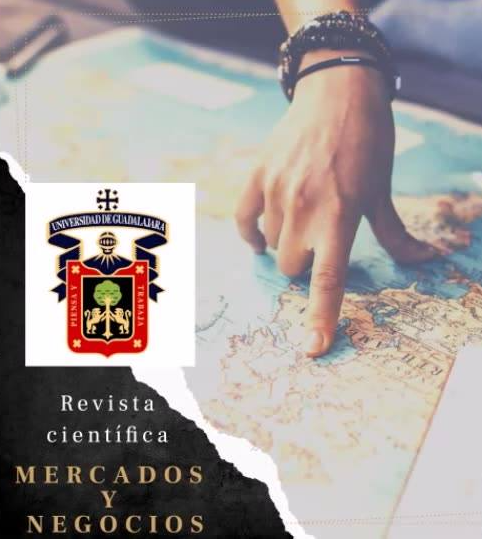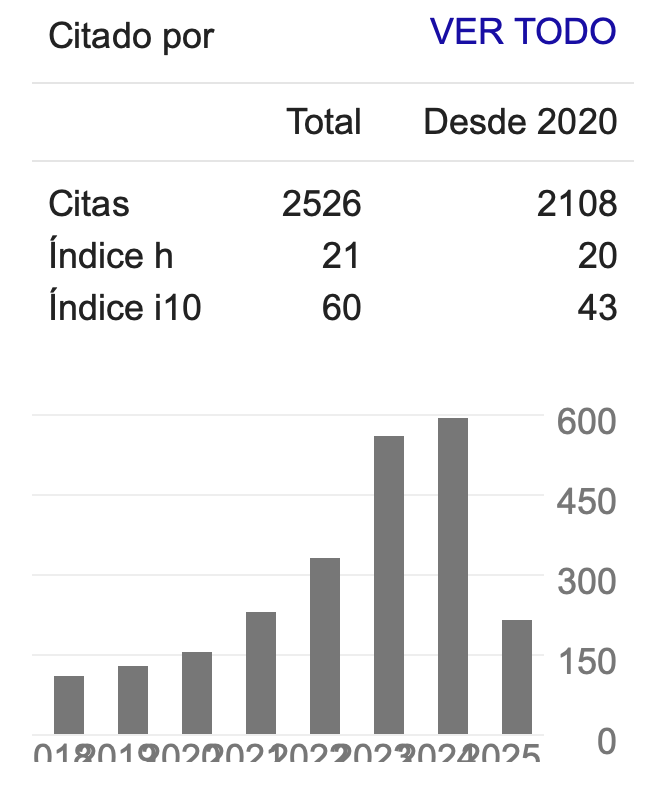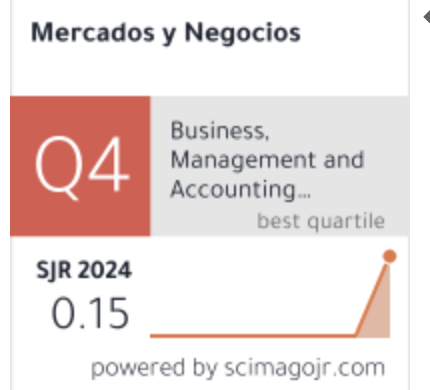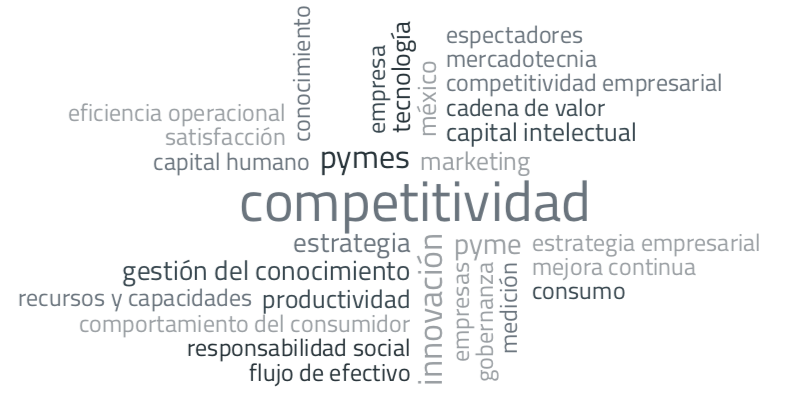La innovación y el capital intelectual: factores de competitividad en la pyme manufacturera
DOI:
https://doi.org/10.32870/myn.v0i28.5251Keywords:
innovación, capital intelectual, competitividad, pyme manufacturera.Abstract
El presente trabajo de investigación pretende mostrar la innovación y el capital intelectual como factores de competitividad para la pequeña y mediana empresa manufacturera. Para esto, con una muestra de 150 pymes del sector manufacturero del estado de aguascalientes, México, se realizó un análisis factorial exploratoria y confirmatoria para evaluar la fiabilidad y validez de las escalas de cada uno de los bloques utilizados, así como un análisis de ecuaciones estructurales con la finalidad de comprobar si la estructura del modelo está correctamente diseñada. Los resultados obtenidos muestran una evidencia empírica de que la innovación y el capital intelectual representan factores significativos en la competitividad del tipo de empresas sujetas a estudio.References
Anderson, J. C., & Gerbing, D. W. (1988). Structural equation modeling in practice: A review and recommended two-step approach. Psychological bulletin, 103(3), 411.
Arellano, S. A. B. (2008). Una aproximación a la construcción del pensamiento neoshumpeteriano: más allá del debate entre ortodoxos y heterodoxos.Información Comercial Española, ICE: Revista de economía, (845), 135-146.
Bagozzi, R. P., & Yi, Y. (1988). On the evaluation of structural equation models. Journal of the academy of marketing science, 16(1), 74-94.
Barney, J. (1991). Firm resources and sustained competitive advantage.Journal of management, 17(1), 99-120.
Barsky, N. P., & Marchant, G. (2000). The most valuable resource-measuring and managing intellectual capital. Strategic Finance, 81(8), 58.
Bontis, N. (1998). Intellectual capital: an exploratory study that develops measures and models. Management decision, 36(2), 63-76.
Bontis, N. (2001). Assessing knowledge assets: a review of the models used to measure intellectual capital. International journal of management reviews,3(1), 41-60.
Bradley, K. (1997). Intellectual capital and the new wealth of nations II.Business Strategy Review, 8(4), 33-44.
Brooking, A., & El Capital Intelectual, B. (1997). Ediciones Paidós Ibérica.
Buckley, P. J., Pass, C. L., & Prescott, K. (1988). Measures of international competitiveness: A critical survey∗†. Journal of marketing management, 4(2), 175-200.
Camisón-Zornoza, C., Lapiedra-Alcamí, R., Segarra-Ciprés, M., & Boronat-Navarro, M. (2004). A meta-analysis of innovation and organizational size.Organization Studies, 25(3), 331-361.
Chang, S. C., Lin, R. J., Chen, J. H., & Huang, L. H. (2005). Manufacturing flexibility and manufacturing proactiveness: empirical evidence from the motherboard industry. Industrial Management & Data Systems, 105(8), 1115-1132.
Choe, K., Booth, D., & Hu, M. (1997). Production competence and its impact on business performance. Journal of Manufacturing Systems, 16(6), 409-421.
Cronbach, L. J. (1951). Coefficient alpha and the internal structure of tests.psychometrika, 16(3), 297-334.
Cuervo, A. (2004). Creación empresarial: sobre los empresarios. Madrid, ES, Universidad Complutense de Madrid, 761-792.
Edvinsson, L., & Malone, M. S. (1998). El capital intelectual: cómo identificar y calcular el valor inexplorado de los recursos intangibles de su empresa. Grupo Editorial Norma.
ENRÍQUEZ, L. A., ADAME, M. G., & GUZMÁN, G. M. (2011). Capital intelectual: la innovación indicador del capital estructural en empresas de sectores estratégicos en Aguascalientes.
Fineman, I., Giza, C., Nahed, B., Lee, S. M., & Hovda, D. (2005). Inhibitions of neocordical plasticity during development by a moderate consecutive brain injury. Journal of Neotrauma, 17(1), 739-749.
Frenkel, A. (2003). Barriers and Limitations in the Development of Industrial Innovation in the Region. European Planning Studies, 11(2), 115-137.
Furio Blasco, E. (2005). Los lenguajes de la Economía. Edición digital a texto completo accesible en www. eumed. net/libros/2005/efb.
Garcia de Leon, C. S. (2007). El Capital intelectual y la Competitividad empresarial.
Grant, R. M. (1996). Prospering in dynamically-competitive environments: Organizational capability as knowledge integration. Organization science, 7(4), 375-387.
Grant, R. M. (2002). Contemporary Strategy Analysis.
Hadjimanolis, A. (2000). An investigation of innovation antecedents in small firms in the context of a small developing country. R&D Management, 30(3), 235-246.
Heckler, C. E. (1996). A Step-by-Step Approach to Using the SAS™ System for Factor Analysis and Structural Equation Modeling. Technometrics, 38(3), 296-297.
Huck, J. F., & McEwen, T. (1991). Competencies needed for small business success: perceptions. Journal of Small Business Management, 29(4), 90.
Kaplan, R. S., & Norton, D. P. (2005). The balanced scorecard: measures that drive performance. Harvard business review, 83(7), 172.
Kavida, V., & Sivakoumar, N. (2009). Intellectual capital: A strategic management perspective. IUP Journal of Knowledge Management, 7(5/6), 55.
Lev, B. (2001). Intangibles: Measurement, management, and reporting.Brookings Institution, Washington DC.
Lloyd-Reason, L., Muller, K., & Wall, S. (2002). Innovation and education policy in SMEs: a Czech perspective. Education+ Training, 44(8/9), 378-387.
López‐Gamero, M. D., Zaragoza‐Sáez, P., Claver‐Cortés, E., & Molina‐Azorín, J. F. (2011). Sustainable development and intangibles: building sustainable intellectual capital. Business Strategy and the Environment, 20(1), 18-37.
Mačerinskienė, I., & Aleknavičiūte, G. (2011). THE EVALUATION OF INTELLECTUAL CAPITAL INFLUENCE ON ENTREPRENEURSHIP.Economics & Management, 16.
Metcalfe, J. S., & De Liso, N. (1995). Innovation, capabilities and knowledge: the epistemic connection. unpublished ms.
Monagas-Docasal, M. (2012). El capital intelectual y la gestión del conocimiento. Ingeniería Industrial, 33(2), 142-150.
Morales Vargas, J. C. (2010). La propiedad industrial y su importancia en el comercio. Ciudad de México: IMPI.
Navas, J. E. (2001). El papel de los recursos intangibles en la empresa. Madrid I+ D, 3.
Nunnally, J. C. (81). Bernstein, IH (1994). Psychometric theory. New York: McGraw-Hill.
Pelham, A. M. (1997). Mediating Influences on the Relationsmp between Market Orientation and Profitability in Small Industrial Firms. Journal of Marketing Theory and Practice, 5(3), 55-76.
Pelham, A. M. (2000). Market orientation and other potential influences on performance in small and medium-sized manufacturing firms. Journal of small business management, 38(1), 48.
Rivero, D. (2009). Modelo conceptual para la medición del capital intelectual y un procedimiento para su implementación. Caso hotelero (Doctoral dissertation, tesis doctoral], Matanzas (Cuba), Universidad de Matanzas).
Rubio Bañón, A., & Aragón Sánchez, A. (2006). Competitividad y recursos estratégicos en las pymes. Revista de empresa, 17(1), 32-47.
Salinas Mata, J. E. (1998). Instituto Nacional de Estadística Geografía e Informática (INEGI), organización funcionamiento y servicios. 1989-1995.
Sanchez-Gutierrez, J., Maldonado-Guzman, G., Gonzalez-Uribe, E. G., & Ortiz-Barrera, M. A. (2012, January). Intellectual Capital as Competitiveness Factor in SME's Manufacturing Industry in Guadalajara, Mexico. In Competition Forum (Vol. 10, No. 1, p. 103). American Society for Competitiveness.
Santana, F. B., Velázquez, J. A. D., & Martel, M. C. V. (2006). Concepto, perspectivas y medida del Crecimiento empresarial. Cuadernos de administración, 19(31), 165-195.
Schumpeter, J. A. (1912). 1934, The Theory of Economic Development: An Inquiry into Profits, Capital, Credit, Interest and the Business Cycle. Trans. Redvers Opie. Cambridge, MA: Harvard University Press.
Stewart, T. A. (1998). Capital intelectual: la nueva riqueza de las organizaciones.
Stewart, T., & Ruckdeschel, C. (1998). Intellectual capital: The new wealth of organizations.
Vargas, B., & Del Castillo, C. (2008). Competitividad sostenible de la pequeña empresa: un modelo de promoción de capacidades endógenas para promover ventajas competitivas sostenibles y alta productividad. The bi-annual academic publication of Universidad ESAN, 13(24), June-2008.
Varma, S., Wadhwa, S., & Deshmukh, S. G. (2006). Implementing supply chain management in a firm: issues and remedies. Asia Pacific Journal of Marketing and Logistics, 18(3), 223-243.
Warren, L., & Hutchinson, W. E. (2000). Success factors for high-technology SMEs: A case Study from Australia. Journal of Small Business Management,38(3), 86.
Witt, U. (2002). How evolutionary is Schumpeter's theory of economic development?. Industry and innovation, 9(1-2), 7-22.
Downloads
Published
How to Cite
Issue
Section
License
Mercados y Negocios by Department of Mercadotecnia y Negocios Internacionales. University of Guadalajara is licensed under a License Creative Commons Attribution-NonCommercial 4.0 International.
The author retains the copyright.








